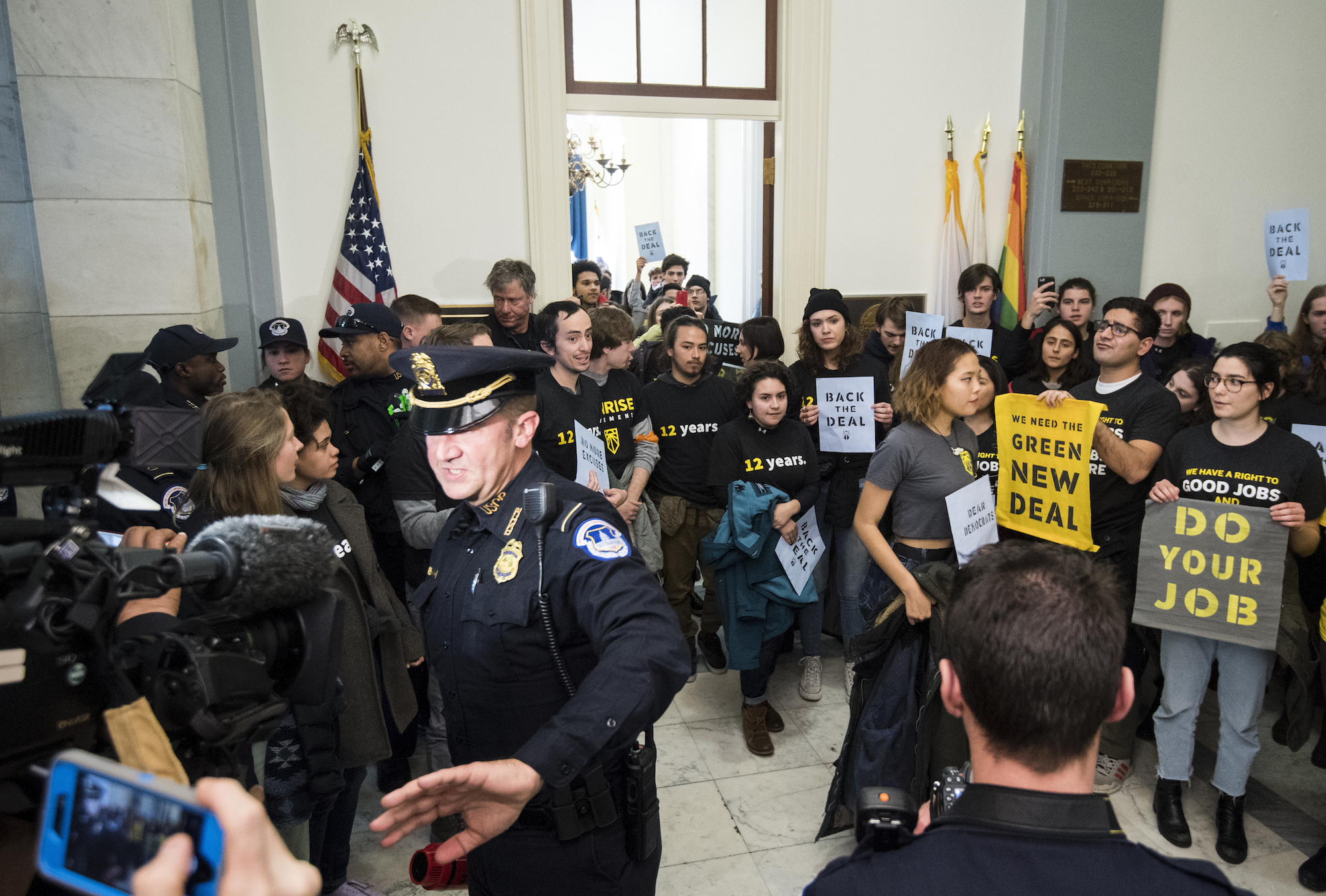Sign up for the daily CJR newsletter.
In the summer of 2018, Esquire summed up the US media’s climate mood board with a feature on traumatized climate scientists, titled, “When the End of Civilization is Your Day Job.” That summer, the National Oceanic Atmospheric Administration reported another astounding leap in atmospheric CO2 concentrations, and its acting head—a Trump appointee—reportedly floated purging the word “climate” from the agency’s mission statement. Climate news was frightening, and often frighteningly absurd.
So when Mothers of Invention, a climate podcast, premiered that summer, it sounded like a broadcast from an alternate, better reality. In it, Mary Robinson, Ireland’s first female president and former United Nations High Commissioner of Human Rights, and her co-host Maeve Higgins, an Irish comedian and writer, interviewed women and girls, largely from the global south and Indigenous communities, who were tackling the climate crisis with brave, ingenious work. Their lens: climate justice. Between Robinson’s pragmatism and Higgins’ cheeky lightness, a sense of “we’ve got this” permeated each episode.
Had it launched just a few years earlier, Mothers of Invention might have seemed a valiant but lesser-known climate voice—much like Inside Climate News or Yale Climate Connections, which have long centered climate narratives glossed over by mainstream news outlets. Today, however, Mothers of Invention, now also co-hosted and produced by Thimali Kodikara, operates in a far less lonely space. In the past year, a host of new solutions-focused climate podcasts launched from prominent outlets; they include Gimlet’s How to Save a Planet, Grist’s Temperature Check, and A Matter of Degrees—whose goal, according to its creators, is to help listeners “see the levers of power behind climate change — and how to empower yourself.” Then there are new efforts from legacy print outlets—from the Washington Post’s “Climate Solutions” section, to the New York Times’ Climate Solutions: A Special Report, to the solutions-oriented Bloomberg Green, which aims, per editor Aaron Rutkoff, to be to the climate-change era what Wired was to the dot-com era and Rolling Stone to the rock ’n’ roll ’60s. A growing number of US news outlets are focusing not only on the threats or impacts of climate change, but—finally—on what we can possibly do about it.
The new climate solutions journalism takes climate change’s reality and importance as given, and goes forward from there, in what feels like a healthy human decision to endure.
SOME OF THE SHIFT TO SOLUTIONS can be traced to a general growth in climate reporting in key print outlets. The Guardian, which partners with CJR and The Nation on Covering Climate Now, led much of the pack with its 2015 podcast and campaign, “The Biggest Story in the World.” At the New York Times, which founded a “Climate Desk” in 2017, the climate story count has been rising roughly in line with average global temperatures. (The same can’t be said for all news outlets; at the Wall Street Journal, climate story rates have pretty much flatlined since 2000, according to data from Colorado University’s Media and Climate Change Observatory, and corporate broadcast news coverage remains meager.)
But general climate coverage growth is not the only reason for the shift. Elizabeth Kolbert, New Yorker climate writer, credits two drivers, starting with novelty. The story of the world getting hotter and its impacts is, she said, citing personal experience, “a really hard story to keep writing,” adding, “You could write that story every single day, but it doesn’t constitute news anymore.” Then there is the general sense that readers find climate news depressing, which contributes to a second driver: “the pressure of ‘Okay, it’s bad, so what are we going to do about it?’”
We may be emerging from the brief, intense “It’s Bad” era of climate journalism, which Rutkoff and climate scientist Michael Mann call “doomish.” Nathaniel Rich’s Losing Earth told the story of how the US failed to act on climate in 1980 when the scientific mandate to do so was more than clear. David Wallace-Wells’ The Uninhabitable Earth, which grew from his viral 2017 New York Magazine essay, presented a litany of plagues. Bird-loving novelist Jonathan Franzen’s New Yorker essay—whose subtitle warned readers of an unpreventable “apocalypse”—drew particular ire for its alleged dangerous defeatism and, per Green New Deal architect Rhiana Gunn-Wright, the white male privilege of giving up. (An editor’s note appended to the story mentioned that it had “mischaracterized the scientific consensus around a ‘point of no return.’”)
To be fair, the “It’s Bad” era was itself a reaction to a longer, more problematic, “It’s Real” era. In that strata, Al Gore, Bill McKibben, and Kolbert, with her 2006 book Field Notes from a Catastrophe, made the lonely case for climate change’s existence and centrality, countering rampant, manufactured right-wing denialism.
The new climate solutions journalism takes climate change’s reality and importance as given, and goes forward from there, in what feels like a healthy human decision to endure, even on a grievously injured planet. “There was a lot of reporting about how bad it was,” says Gimlet co-founder Alex Blumberg, who co-hosts How to Save a Planet with Dr. Ayana Elizabeth Johnson. Such reporting, he adds, was necessary. “But my question was, What should we do about it? Should we just throw up our hands and die?”
But focusing on climate solutions is not just an editorial decision or psychological best practice. It’s a response to real political, technical, and business solutions, which quixotically ripened during the Trump administration and gave climate journalists fresh stories to tell.
Consider that doomish summer of 2018, and all that had not yet happened. The deadliest wildfire season in California hadn’t yet burned, and the United Nation’s influential 1.5 Degree Report, with its deep decarbonization deadline, hadn’t yet been released, further galvanizing the youth climate movement, which was gathering force but had not yet shown its political muscle. The Sunrise Movement, then a year old, was still months away from the sit-in at Nancy Pelosi’s office, which was held just after Democrats flipped the house and which quickly went viral. It all made for fresh, appealing climate copy; it oxygenated protest movements and further galvanized political will, helping shove climate change to the center of President Biden’s agenda.

Sunrise Movement protesters in the Cannon House Office Building on December 10, 2018. Photo by Bill Clark/CQ Roll Call via AP Images
In terms of technology, even as President Trump had been elected on promises to coal workers, solar was cheaper than coal in many markets, presaging remarkable leaps in renewable energy across the board that could largely enable Biden’s plans for a carbon-free electrical grid by 2035 (per two major studies vividly relayed on How to Save a Planet). Add to that the nascent, creative negative emissions technologies, such as biochar and direct air capture, that are attracting start-up finding.
Rutkoff, who edits Bloomberg Green, sees a wide river of capital flowing in a global transition to a green energy economy. In a welcome letter for the magazine, which launched at Davos in January 2020, John Micklethwait, Bloomberg News editor in chief, wrote that by 2050, $10 trillion will be invested in renewable energy. “Ultimately, when we’re talking about solutions journalism, we’re talking about telling that story,” Rutkoff says. Still, solutions doesn’t imply good news, he clarified, but rather assessing climate solutions (a direct air capture plant’s financing, say) with the same rigor as any business story. It can also mean muckraking journalism that holds Wall Street banks and fossil-fuel companies like Exxon to account for their carbon and spurs investor scrutiny—what Rutkoff has dubbed “emissions journalism,” in which the old financial reporting adage “follow the money” is replaced by “follow the emissions.”
The decision to cover climate solutions doesn’t mean arguing that they’ll work, are adequate, or even that climate change can be somehow “solved.” Kolbert, whose recent book Under a White Sky casts skeptical eye on approaches like direct air capture and geoengineering, points out that even if we were to cut global emissions to zero tomorrow, the planet will continue to heat for some undetermined time, leading to more fires, hurricanes, melting ice, sea rise, and damage. “This is why I don’t think the word ‘solution’ is appropriate,” she says. “At this point, we can only try to minimize the danger.”
It can be difficult to reconcile a solutions-oriented approach to coverage with the climate crisis’s urgency and enormity. “Optimism feels a little Pollyannaish, like, ‘Oh we’re going to fix it,’” Kendra Pierre-Louis, a reporter with How to Save a Planet, says. The line that show tries to hold, she says, “is, when we say that a thing can be done, it is a thing that can be done.” In the 1950s, she points out, we didn’t have the technology to power a national grid on renewables. Now we can.
I’m trying to build a culture of movement, because we haven’t got time for anything else and we all need to take responsibility.
ON MOTHERS OF INVENTION, climate solutions can feature a technical solution, like Indigenous climate activist Wahleah Johns’ successful effort to bring solar power to families in the Navajo Nation. But the narrative always hinges on a movement toward equity and biodiversity, powered by the people most impacted by the climate crisis, starting with, as co-host Robinson has repeatedly pointed out, women. (Hence the show’s tagline: “Climate change is a man-made problem — with a feminist solution!) In this way, the show is itself a climate solution, inviting “Mothers”—primarily women from from communities rarely centered by the media, let alone as problem-solvers—onto the show to share best practices, not just as guests but as co-hosts, and encourages listeners to see themselves as Mothers, too. Thimali Kodikara, who also writes the show’s editorial and social impact strategy, says, “With Mothers of Invention, I’m trying to build a culture of movement, because we haven’t got time for anything else and we all need to take responsibility.”
Mothers of Invention is an experiment that complicates any idea of traditional journalism. But in a sense, so does all climate solutions journalism. Classically, reporters like to report on things that have happened, with evidence; climate solutions demand that reporters report on things that could happen, with hypotheses. Writing about climate solutions, even old-school journalists dance with science fiction. The title of Kolbert’s recent book is derived from predictions that geoengineering, also known as solar radiation management, could turn blue skies white.
No one is playing it safe in this journalism—least of all Rutkoff, who asked Kim Stanley Robinson, science-fiction novelist and self-professed American leftist, to write an essay closing out each quarterly magazine. In the essays, Robinson says, he is “trying to persuade capitalists to quickly transition” to a “decarbonized civilization that’s in sustainable balance with the biosphere,” using terms and logic they find acceptable: “In effect, you can’t make a good profit when the world is destroyed and people are angry at you.”
For topics, Robinson has drawn from his recent realist-utopian climate novel Ministry for the Future, which made President Obama’s 2020 reading list. In one, Robinson pitches “the carbon coin,” more formally called carbon quantitative easing – an experimental economic instrument that, backed by central banks, would pay people to sequester carbon. In the essay, Robinson concludes, “We have to change, because the direction we’re headed now leads to disaster. And that change will have to involve figuring out ways to pay ourselves to do good work.” In Ministry, in the wake of grievous losses, the carbon coin corrects capitalism’s chief market failure and saves human civilization.
It’s not possible to unbleach the coral reefs or unburn the fires. But at its most progressive, climate solutions journalism frames the future as collectively authored and imagined. In this vein, Kodikara, of Mothers of Invention, mentions an eight-minute “minisode” in which everyone on the show—mainly, she says, Black and brown women and gender-nonconforming folks—typed visions of their “climate safe future” into a Google doc, from which she crafted a script set in the US in 2032, shortly after the election of the first Indigenous president. With the episode, which ran the day after the 2020 elections, she’d wanted to allay anxieties—to give everyone “something to march for.”
One story has stayed with her. A tomato plant had grown up near her stoop; as she and a friend watched, a man in a wheelchair rolled up, picked off the tomatoes, and ate them like candy. “How awesome would it be if any of us could pick vegetables and fruits walking to our friend’s house,” she says. “It would be absolutely lifechanging!” You can almost see it, this future, growing there—no crazier than anything else that has gone down since 2016. Why not pick that one?
ICYMI: Living through the climate emergency
This story has been updated.
Has America ever needed a media defender more than now? Help us by joining CJR today.








